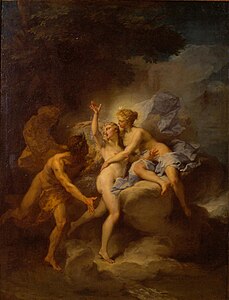Jean Restout the Younger
Jean Restout the Younger | |
|---|---|
Jean Restout le Jeune | |
Académie Royale de Peinture et de Sculpture | |
| In office 1760–1763 | |
| Monarch | Louis XV |
| Preceded by | Louis de Silvestre |
| Succeeded by | Jacques Dumont le Romain |
Jean Restout the Younger[a] (26 March 1692 – 1 January 1768) was a French artist, who worked in painting and drawing. Although little remembered today, Restout was well-respected by his contemporaries for his religious compositions.
Biography
Restout was born in the city of Rouen in Normandy on 26 March 1692.[1] He was a son and pupil of Jean Restout the Elder, a church painter from Caen.[2] His mother, Marie Madeleine Jouvenet (c. 1655 – before 1729), was also an artist and a sister of the famed painter Jean Jouvenet.[3]
Jean Restout the Elder died suddenly in 1702 and thereafter two of his brothers, the artists Jacques and Eustache, cared for the ten-year-old Restout. In 1707, following their introduction to one another by Eustache, Restout entered Jouvenet's studio in Paris.[4] He rose to a position of some importance while there, even assisting his uncle in the completion of his last commissions.[5] Furthermore, Jouvenet gave Restout the majority of his many drawings, a number of which were figure studies.[6]
On 29 May 1717, Restout was admitted to the
Restout's career as a religious painter began in earnest in 1730, when he received a dual commission from the Benedictine abbey at Bourgueil near Chinon.[11] Both paintings, the Ecstasy of St Benedict and the Death of St. Scholastica, center around monastic figures.[12][13]
In 1729, Restout married Marie-Anne Hallé (1704–1784), daughter of Academy painter Claude-Guy Hallé.[14] In 1732, she gave birth to their only child, Jean-Bernard Restout. He, like his father, had a successful, though rather conventional, painting career: he won the Prix de Rome in 1758, was admitted to the Academy in 1769, and exhibited regularly at the Paris Salon.[15]
Restout died in the Louvre Palace on 1 January 1768. His late baroque classicism rendered his altarpieces, such as the Death of St. Scholastica an isolated achievement that ran counter to his rococo contemporaries.[16]
Selected works
- Saint Bruno in Prayer (1711) – Musée des Beaux-Arts de Dole.
- Portrait of Dom Louis Daudouin du Basset, a Carthusian monk of Gaillon (1716) – Musée des Beaux-Arts de Rouen.
- Venus Ordering Arms from Vulcan for Aeneas (1717) – Los Angeles County Museum of Art.[17]
- Venus Presenting Arms to Aeneas (1717) – Ottawa, National Gallery of Canada.[18]
- Alpheus and Arethusa (1720) – Musée des Beaux-Arts de Rouen.
- Ecstasy of St Benedict (1730) – Musée des Beaux-Arts de Tours.
- Death of St Scholastica (1730) – Musée des Beaux-Arts de Tours.
- Alexander and his Doctor (1747) – Musée de Picardie, Amiens.[19]
- Martyrdom of St. Andrew (1749) – Musée de Grenoble.
- Triumph of Bacchus and Ariadne (1757) – Sanssouci, Potsdam.
- Orpheus and Eurydice (1763) – Musée des Beaux-Arts de Rennes.
Gallery
Paintings
-
Saint Bruno in Prayer (1711)
-
Venus Ordering Arms from Vulcan for Aeneas (1717)
-
Alpheus and Arethusa (1720)
-
Death of St Scholastica (1730)
-
Pentecost (1732)
-
Boy in a Child's Chair or Portrait de Jean-Bernard Restout (1736)
-
Martyrdom of St. Andrew (1749)
-
Triumph of Bacchus and Ariadne (1757)
Drawings
-
Seated Carthusian Holding an Open Book (1711)
-
Head of a Bearded Man (c. 1750)
-
Funeral of François Duplessis de Mornay
Notes and references
Notes
- ^ Also known as Jean II Restout or Jean Restout II
References
- ^ Conisbee, Philip (2003). "Restout, Jean, II". Grove Art Online. Oxford University Press. Retrieved 1 August 2023.
- ISBN 978-0-19-977378-7. Retrieved 1 August 2023.
- ISBN 978-0-19-977378-7. Retrieved 1 August 2023.
- ISBN 1885444133. Retrieved 1 August 2023.
- – via JSTOR.
- ^ Schnapper, Antoine (Summer 1967). ""Les Compositions" of Jean Jouvenet". Master Drawings. 5 (2): 135–143, 199–208 – via JSTOR.
- ^ Restout, Jean-Bernard; Cochin, Charles-Nicolas, eds. (1771). "Restout". Galerie françoise, ou Portraits des hommes et des femmes célèbres qui ont paru en France (in French). Vol. II. Paris: Jean-Thomas Hérissant (a.k.a. Herissant le fils), printer-bookseller. Retrieved 2 August 2023.
- ISBN 978-0-19-977378-7. Retrieved 1 August 2023.
- ISSN 0711-2866.
- ^ Guiffrey, Jules; Barthélemy, Joseph, eds. (1908). Liste des pensionnaires de l'Académie de France à Rome de 1663 à 1907 (in French). Paris: Firmin-Didot. p. 23.
- ISBN 0-7148-2147-0. Retrieved 4 August 2023.
- ^ Join-Lambert, Sophie (2008). "L'Extase de saint Benoît". mba.tours.fr (in French). Retrieved 4 August 2023.
- ^ Join-Lambert, Sophie (2008). "La Mort de sainte Scholastique". mba.tours.fr (in French). Retrieved 4 August 2023.
- ^ Estournet, O. (1905). La Famille des Hallé (in French). Réunion des Sociétés des beaux-arts des départements. pp. 47–50.
- ^ Turner, S. J. (2003). "Restout, Jean-Bernard". Grove Art Online. Oxford University Press. Retrieved 4 August 2023.
- ISBN 978-0-500-20050-6. Retrieved 4 August 2023.
- ^ Marandel, J. Patrice (2011). "Venus Ordering Arms from Vulcan for Aeneas". collections.lacma.org. Los Angeles County Museum of Art. Retrieved 2 August 2023.
- ^ "Venus Presenting Arms to Aeneas". gallery.ca. National Gallery of Canada. Retrieved 2 August 2023.
- ^ "Jean Restout, "Alexandre malade recevant le breuvage du médecin Philippe"". amiens.fr (in French). Retrieved 3 August 2023.
Further reading
- Réau, Louis; Messelet, Jean; Adhémar, Jean (1938). "Carle Vanloo, Jean Restout: Les lithographies de paysages en France à l'époque romantique". Nouvelles archives de l'art français (in French). Vol. 19. Société de l'histoire de l'art français.
- OCLC 489634124.
- Gouzi, Christine (2000). Jean Restout, 1692-1768 : Peintre d'histoire à Paris (in French). Paris: Arthena. OCLC 46462444.
- Gouzi, Christine (2013). Jean Restout et les miracles de Saint-Médard (in French). OCLC 894848499.
External links
 Media related to Jean II Restout at Wikimedia Commons
Media related to Jean II Restout at Wikimedia Commons











